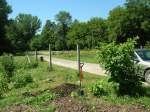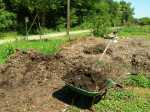Common Sense
Looking across the horizon, the notion that the earth was flat was obvious to the eye, and as all eyes saw it that way, it was deemed common sense. We tend to look only as far as what we experience, becoming comfortable with the way we see, and say there is no other way. At most one tends to look only as far as what trusted people know; through observation, measurement and travel, peoples worldview slowly changed from flat to round, from linear to circular, and the ground beneath their most basic assumptions changed, though the world looked the same.
People often go much further in undoing common sense, and reveal a world to themselves of their own making. As teeming millions worked the soil, plowing it with the help of farm animals, they directly experienced the work required to reap the necessary fruits of survival, and such hard work was deemed common sense, but when the tractor was built, millions were made aware that the possibilities were not so limited.
Yet, to complicate the matter of reality further, as much as people reveal new possibilities to themselves, they often create their own illusions. It is in fact an almost daily occurrence that people make mistakes, and create their own problems. Mistakes can turn into ongoing lifestyles and are perpetuated for generations and centuries and deemed common sense with the “test of time”. Multiple generations lived on slavery and the oppression of women and children for hundreds or even thousands of years, as whole societies very psychology becomes dependent on it. After all, if one cannot always trust what they see, that should also be applied to what appears to have been revealed. If the tractor seemed to reveal one thing, it was that just if something has been done for generations, it does not deem it right or necessary.
Foraging
In order to examine the perceptions we create of our world, we must once in a while challenge ourselves. Was the tractor really an improvement over the plow? To truly begin to examine how we relate to our most precious resources, one should look at the assumptions held about farming itself. To begin, why did it take 5000 years to go from the plow to the tractor, while it took 150,000 years to go from foraging to agriculture, something requiring far less complexity in its early stages? We can give many answers based on our assumptions, but it may help the most to directly observe the few hunter-gathers that remain today. Indeed, there are some people who likely still think the earth is flat and have never heard of a tractor or plow. Looking at such people as they had once glanced across the horizon, modernites deemed it common sense that they are ignorant savages, perpetually living on the edge of starvation. Even the most prominent intellectuals devoted much time to explaining these peoples inherent inferiority. While the field of anthropology in the West was initially devoted to this topic, things started to change along with the political environment in the 1960s. Taking a closer look, anthropologists such as James Woodburn found that groups such as the Hadza in the deserts of Tanzania live in an area abundantly rich for their numbers. Observing their daily lives, Woodburn found that the Hadza spent only two hours a day collecting all the food they needed, which was done socially at an even pace in groups. Learning this in an introductory book to cultural anthropology years ago, in a chapter entitled The Meaning of Progress, my world view turned upside down. While I considered the plow an improvement over foraging, and the tractor an improvement over the plow, I slowly realized that progress was, if anything, nonlinear. The Ju/Wasi are a similar group in Southern Africa, living a life of abundance. While there are 80 species of edible plants, they choose to only use around 20. Their staple is the Mongongo Nut – a daily diet of around 300 nuts (probably around 200 grams) provides over 1200 calories and 56 grams of protein. A single grove, of which there are many, produces thousands of kilograms of nuts. Their meat intake, provided by porcupines and hares, and the occasional giraffe, antelope, or other large game, provided 175-200 pounds per person per year, on par with consumption in developed countries. The Ju/Wasi also live in groups of 30-40 when watering holes are more evenly distributed, and 100-200 when only large watering holes remain during the dry season. The groups are so small that they are inherently self-governing and do not need a standing government to ensure fairness. Studies that include archeological evidence suggest that they have in fact lived in peace in the area for around 20,000 years. Genetic studies have shown that they have, because of their stable lifestyles, constituted a separate descent from the origin of humanity. If one takes a closer look, their appearance does not resemble most Africans. Their appearance have characteristics of people all over the world, from the hair of Africans to the higher cheekbones of East Asians.

Ju/Wasi tribeswoman
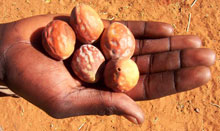
mongongo nuts
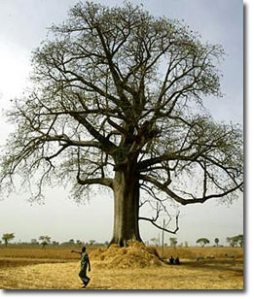
mongongo tree
The irony of the Ju/Wasi’s abundance was seen in the movie The Gods Must Be Crazy, in which it depicted a tribe praising the gods for providing them a world without want. While it is an exaggeration and a stereotype of the noble savage, as well as having many racist connotations, it showed the ironies of abundance. When an airplane (a noisy bird) flew over and dropped a bottle of coke – seen as junk by the pilot – it was a strange object that must have been a gift from the Gods. People used it as a tool for a variety of things, but as there was only one, it was too scarce a resource, and people experienced property, one could say poverty, for the first time, along with jealousy, anger, and even violence. Xi, the main character, decides that the bottle is evil, and goes on a journey to throw it off the edge of the world, in the process encountering modern civilization. The movie actually used people from a Ju/Wasi tribe. When the actor who played Xi was paid a small amount for the movie, he literally let it blow away as he had no attachment to money.
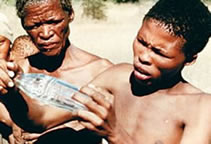
a scene from the Gods Must be Crazy - Xi holding the coke bottle
It is common for hunter-gatherer groups to know that one can plant a seed and watch it grow, but the extra work needed to grow and maintain crops would be unnecessary and illogical. The reason that some people at some point in time decided to do this was, of course, because of the increase in numbers of people. If a population does not stabilize below a certain threshold, people either had to engage in war or change the way they dealt with their resources, or of course, a combination of both. The only places that would allow such a growth would be areas of productive soil, whether in forests or grasslands. In fact, one thing that has protected hunter-gatherers like the Ju/Wasi and Hadza for so long is that the area was likely seen as inhospitable for agriculture.
People went from hunting and gathering to slash-and-burn, or swidden agriculture, to irrigation agriculture, and larger and larger groups were needed to regulate the use of water and the storage and distribution of food and later trade, going from city states to nation-states and empires. Each level of complexity required more work to sustain it. The following data, taken from Eric Wolf in 1966 shows the results:
|
Days of Labor Per Acre Per Harvest By Type of Agriculture
|
|
Type of Agriculture
|
Days of Labor Per Acre
|
| Advanced swidden |
18-25
|
| Plow cultivation |
20
|
| Hoe Cultivation |
58
|
| Irrigation Agriculture |
90-178
|
|
Land Needed to Feed 100 Families Using Different Agricultural Methods
|
|
Agricultural Method
|
Number of Acres Needed to Feed 100 Families
|
| Swidden Agriculture |
3,000
|
| Swidden with garden plots |
1,600
|
| Irrigation Agriculture |
90-200
|
Some anthropologists now go as far as to claim that our decision to leave a life of hunting and gathering was the worst decision we ever made. While this may be taking things a little far, a closer look at the source of the diet of the Ju/Wasi may reveal deeper insights. Mongongo trees exist in groves, separated by large distances, and a single tree can feed many people, and a grove dozens. Trees, unlike domesticated grains, require little to no maintenance once they are rooted, and in the case of the Ju/Wasi, they seed and take care of themselves.
Edible Weeds
There are in fact many trees throughout the world that, like the Mongongo, are tremendously productive for the human diet. Last year I came across Rose Barlow’s weblog on foraging, where I saw that one could actually harvest and eat acorns from oak trees growing around them. According to the weblog, “100 grams of acorn flour (roughly one cup) contains a whopping 500 calories, 30 grams of fat, and 54 grams of carbohydrates”. Down the street from me, there was an oak tree, and at the time, the acorns were dropping all over the lawn and along the street. My friend Matt and I gathered them, and cracked them individually, ground them in a coffee grinder to make flour, and made bread out of it (see foraging). It was a demonstration in why people in various environments also had to take up cooking – acorns have to be boiled to leach out the tannins, which are poisonous and bitter, and were used traditionally to tan hides. Apparently Native Americans and Europeans alike used acorns as a staple. This makes one think – what if such trees were planted in such a density as to produce enough grain and protein equivalents to fill one’s diet? It takes long term planning, as trees grow slowly, but once they do, one could be self-sufficient with little time required. In other words, with enough knowledge and time, could people could become hunter-gatherers in a densely populated, urban environment? Doing a careful analysis, I found that oak trees can produce enough grain equivalents for 3-5 people per acre, exceeding modern grain production, but significantly less than what would be required by such local agriculture (double digging can produce grains for around 18 people per acre). Perhaps it is possible to create oaks that produce higher yields. I have heard that people have been able to successfully dwarf nut trees and induce them to produce in a few years, whereas oaks can take nearly 80 years to mature to full production. Perhaps if the possibilities provided by domestication and technology were applied to the possibilities of abundance that many hunter-gatherers live in, we could have the best of both worlds.
Less is More
Years ago Masanubo Fukuoka worked as a microbiologist in a lab devoted to some of the most important modern agricultural discoveries, such as the isolation of giberellin, the hormone that makes plants grow. The very biology of plants could be induced to produce greater yields. Fukuoka was very devoted to his work, and one day collapsed. He woke up and had a revelation, and concluded that, despite the fact that he was finding the inner workings of life, “Humanity knows nothing”. People found him to be eccentric, as he wandered along beaches and across the countryside. One day he came across a rice plant growing wild in a ditch. At that moment it clicked for him, and he returned to his childhood village, and practiced his philosophy in farming. He dubbed this method Wu Wei, the closest equivalent in English being Do-Nothing Farming. He grew rice, and without a plow or even compost. He simply mimicked nature – for example, after the rice was threshed, the straw was thrown back where it came from, decomposing into the ground and building an even layer of humus. Every year he was able to do less and less, as the soil built fertility, and the whole ecosystem adapted to the rhythmic function. He achieved comparable yields to modern farming with less effort. When people repeatedly studied his techniques, it was difficult to reproduce, because he had developed an intrinsic and deep understanding of how the farm worked, which required years of doing less and less.
Fukuoka tapped a deep insight into the nature of relationships of mutual dependence. While domesticated rice cannot grow without the intervention of farmers, the fact that “humanity knows nothing” was blatantly demonstrated to Fukuoka when he saw the rice plant in the ditch. Though it came to Japan as a domesticated plant, some plants strayed and through their own efforts became wild, being able to seed themselves and require their own intervention. Though traditional and modern farming both require increasing knowledge, Fukuoka asked what can one not do, so that the plants and ecosystem can do it themselves, like the rice plant? This experience suggested that as much as we domesticated plants and animals, they domesticated us, and rather than us not being at the whims of nature anymore, we are often only at the whims of a dependence of our own making.
The “goal” of Fukuoka’s do-nothing farming is based on the idea that if one does not do more and more, and has nature do more and more, one can achieve the point where human intervention becomes absolutely minimal. What Fukuoka may have meant when he said “humanity does not know” is that we do not deliberately know our knowing, in the same way that we do not see our seeing, feel our feeling and so on. In the same way, ultimately growing our growing is futile. Plants grow themselves, and in fact the more one meddles with plants, the more one does anything too deliberately, the more it destroys the original nature of what does. If one has ever tried to count their breath while breathing normally, it is nearly impossible. Yet there are people who meditate on their breath until they gain an awareness of normal breath. Similarly, growing food must be increasingly less deliberate. While any farmer can at some point do what they do naturally, almost in their sleep, it is a different thing to, as one does with their breathing, be able to gain such a conscious awareness through practicing mindfulness. As one who starts with their breath, it is initially very deliberate, but as the practice goes on, the ability is increasingly gained. For Fukuoka, agriculture was a meditative, spiritual practice. Ultimately what is gained is a conscious awareness of ones part in an ecosystem.
When farming on a smaller scale, with careful observation, Fukuoka found that he could plant vegetables that provided themselves perennially. He would initially sow a mix of vegetable and clover seed among growing weeds, and let things take their course, observing and tweaking things along the way. Some seeds would germinate, but vanish in weeds, while some survive and a few would flourish. He would allow plants to grow, and remove many of them to be eaten, but leave several here and there to seed themselves, becoming semi-wild. This he acknowledges is possible for a family of 5-6 people, over an area of 100 square yards, but larger scale production requires systematic rotations, like how he grew rice.
The stark metaphor that was revealed to Fukuoka when he saw the rice plant in the ditch goes much deeper. Once while working on a farm, someone showed me various weeds that found places to grow themselves where they could. He showed me lambsquarters, which he said was like a wild spinach, and burdock, which could be boiled and eaten. From then on I saw the plants everywhere – in gardens, lawns, and sidewalk cracks. Someone once told me that on a farm he worked on in New York, they would weed the lambsquarters and sell them in the market at a high price. I recently returned from India, where I saw it growing in the desert climate of Rajasthan and the more tropical climate in Tamil Nadu, and people ate it regularly in both places. Lambsquarters is a relative of spinach, and is far healthier. When observing this, one then has to ask – why are we growing vegetables when all around us, vegetables are growing themselves? People in fact find them a tremendous nuisance when imposing vegetables that require a tremendous amount of work. Perhaps when people realize the opportunities growing around them, they can take advantage of them, going even further than Fukuoka.
Over All
from the Tao de Ching
The Way never does anything,
and everything gets done.
If those in power could hold to the Way,
the ten thousand things
would look after themselves.
If even so they tried to act,
I’d quiet them with the nameless,
the natural.
In the unnamed, in the unshapen,
is not wanting.
In not wanting is stillness.
In stillness all under heaven rests.
Do-Nothing Eating
The dependence that Fukuoka and others have found agriculture to rest on goes much beyond the farmer – it goes into grocery stores, markets, the kitchen, the dinner table, the mouth and the body. It transcends the time and space of one individual or family. The whole process of food production is deeply convoluted by how complex food production is and has become. The ecology of the modern day economy is very strange. People do some work unrelated to food for which they get paid, from which they can forage in the supermarket. In fact, anyone with sufficiently low income qualifies for food assistance, or someone who has made lucrative investments can retire off the income gained through others labor. Food is neatly packaged, and is almost bizarrely disconnected to where it came from. It is common for children to think that food comes from cans, and almost universal for people to not know what the plant looked like, whether it is a small plant, bush, or tree. This disconnects the majority of people from how much work is required to grow food, as the work they did to pay for the food is hardly ever equivalent. This comes from the great benefits of specialization, where people share burdens and are able to create much more than what they can as individuals. On the more basic level, most households in the world have a mother and wife that cooks, and a father and husband that “brings home the bacon”. This eases the burden for the individual, but when people are disconnected from the greater picture of their interrelationships, that is beyond the individual and beyond the family, or even the community, it can lead to a dependence on the whole. The family expects a certain diet from the matriarch, and likewise they depend on her for all their diet. Growing up, I hardly cooked any meals for my family, and was completely dependent on my Mom for her cooking. In college I lived in the dorms, where I ate in the dining hall for a flat charge. If I got married right out of college and my marriage was a traditional one, I would still be eating the same things that my Mom cooked, with the same amount of labor that went into it. Furthermore, we eat what is available in the supermarket, and farmers provide for what we are willing to buy. Fukuoka sold his rice for a market, or for the dependence of a particular diet, while perhaps he could have grown things that require even less intervention (his purpose was also to demonstrate his ideas).
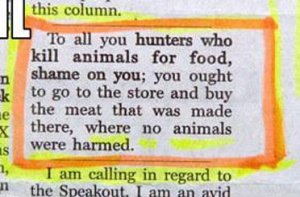
from failblog.org
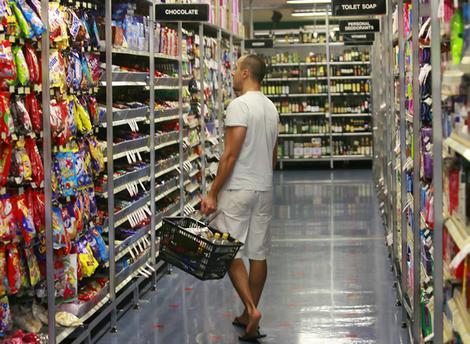
modern foraging
Even to change an individual’s diet can be tremendously difficult, let alone the cohesion it would take for a whole family or society. Even if the food tastes better, one’s body can be use to, or addicted to, a certain diet. I saw a video recently of a group of people with type-2 diabetes who went through a program, and were given a diet of raw food without meat. It was agonizing for them at first, and they all wanted to leave. But within two weeks, some of them did not need to take insulin shots, and after a month, they all lost a tremendous amount of weight. It would have been very difficult for them to do it alone, and it really required the help of the program and the people.
Yet I have found with my own efforts something like a do-nothing eating and cooking that has been much easier, and an attempt to incorporate the whole picture into my diet. I lived alone last year, and had to learn to cook on my own effort. I really took some time figuring out the costs of the food I was eating, and experimented with different things. Soon I was able to cook simple meals that were delicious, from scratch, and cost less than $1.00. At some point I thought about the fact that tomatoes taste good raw. I remember eating raw green peppers when I was little. I learned that on top of taking more time, cooking also takes the majority of nutrients out of food. In fact, there is no botanical difference between a fruit and a vegetable. Yet if someone saw you eating a raw tomato or green pepper like an apple, they would think you are crazy. None of this was entirely new to me, but with the combination of all the right elements – with me cooking and eating for myself, paying for my food, and having done a little bit of foraging and gardening, things have become increasingly clear to me.
Experimenting with ones diet can be one of the most tremendously empowering experiences. I had learned that in his early life, Gandhi’s first demonstrations in self-empowerment were with experimenting with his diet while he was studying in London. Eating the food available in Britain, a notoriously bland cuisine, especially for an Indian, was agonizing. At some point Gandhi decided to focus on the taste of things, eating foods plain and raw. Remembering that, I was was inspired and started to pack lunches and snacks that were literally just a bunch of raw vegetables, buttered bread, and cheese, and it made no difference to me in taste and saved time.
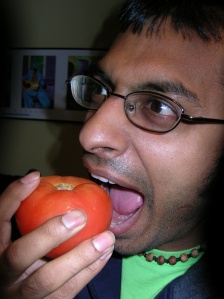
simple, quick, efficient
As I got the hang of cooking and eating as such, I started to go a bit deeper than cooking simple meals. Observing the whole process of food production, from foraging to farming to markets to the dinner table, I have started to apply wu wei to the whole process. If one were to look at wu wei within their small nook of the picture, they could simply go to the supermarket and buy processed food with food stamps that they could heat up in the microwave. In fact, to do less, you have to consider the whole process. Fukuoka used traditional small tools despite the fact that farming could be done more easily and massively for one person with large machinery. The idea was not simply to work less. The idea was to bring the process closer to oneself, and have the whole system do less and less. While cooking things from scratch, I also considered each thing I ate, and the process that was undergone to bring it to me. For example, milk and cheese should be considered, though delicious, nonessential as the level of dependence that is required for a society on cows is tremendous, and people can gain the same amount of nutrition from simpler foods.
While people specialize out of convenience, or out of their desires to do things that they love, or for that matter forced, disconnecting our awareness from our production processes, especially those we rely on most, is in fact dangerous, like driving blindfolded. While we cannot see everything that’s in store for us, agriculture and industry have taught us that we are largely the makers of our fate. But when we create a world of which we are collectively unaware, we are only disempowering ourselves more than ever, being at the whims of ourselves more than we were ever at the whims of nature, and unaware of the possibilities we can collectively create.
Two poems provided by Wendell Berry from his introduction to Fukuoka’s One Straw Revolution:
|
Wordsworth:
Our Meddling Intellect
Misshapes the beauteous form of things –
We murder to dissect
|
William Blake:
He who binds to himself a joy
Doth the winged life destroy
But he who kisses the joy as it flies
Lives in eternity’s sunrise
|




